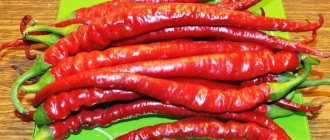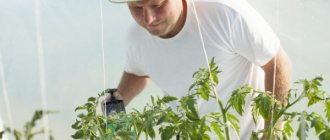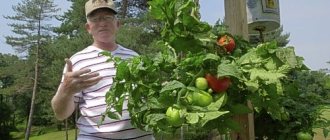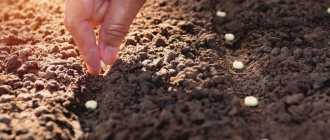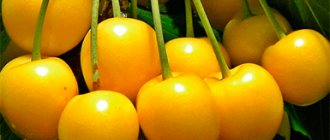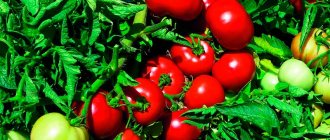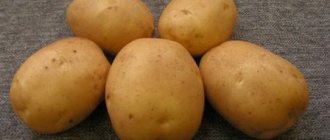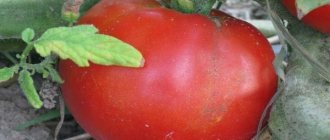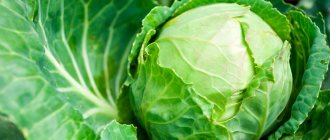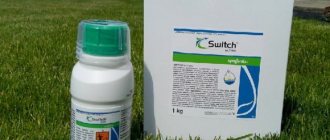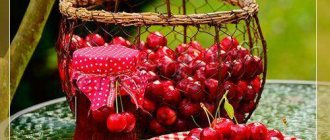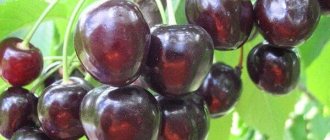Caring for Teremoshka cherries
Its development and productivity depend on the method of caring for cherries. The tree needs watering and fertilizing, as well as crown formation.
Feeding and watering
Cherry varieties Teremoshka are watered 3-4 times during the season:
- when flowering;
- at the beginning of fruiting;
- in the fall during preparation for winter.
If the weather is dry and hot, organize additional moisture. The water must first settle and warm up. If the Teremoshka cherry variety is not 5 years old, 10 liters of water is enough for it. Mature trees require up to 20 liters. You can add fertilizers to the water for irrigation: take 15 g of urea, potassium salt and superphosphate per 10 liters. This composition is suitable for spring feeding. In summer, urea and other nitrogen substances are not used, as they cause active growth of shoots and leaves. Every 3 years the soil is dug up and fertilized with compost.
Weeding and loosening
After watering or precipitation, the soil under the cherry tree is loosened to a depth of 8-10 cm. Weeds are periodically weeded. Loose soil is saturated with oxygen, due to which the roots of the tree better absorb substances and water.
Crown formation
Cherry varieties Teremoshka are pruned in spring or autumn, when the trees' sap flow is slow. Root shoots are removed at any time of the year. Pruning increases cherry yield and fruit quality. High density increases the risk of spreading diseases and pests. The formation of the crown takes 5-6 years. The height of the cherry tree is maintained at 2.5 m, the skeletal branches are shortened to 3 m. In total, 2-3 tiers need to be created. Be sure to cut out old, broken and frozen shoots.
Pollinators of Teremoshka cherry
The Teremoshka cherry is self-sterile; planting pollinators is necessary to form a harvest. It is better to choose 2-3 different varieties that bloom at the same time. Trees are planted every 3-4 m. Pollinators for Teremoshka cherry varieties:
- Bryansk pink. Tree of moderate growth. The fruits are pink, sweet and juicy. The variety is resistant to diseases, rot, and cracking of the pulp.
- Revna. The tree is medium in size and quickly grows shoots. Winter-hardy variety, resistant to fungal diseases. The fruits are juicy, sweet, and have a universal purpose.
- Ovstuzhenka. A small tree with a spherical crown. The flowers are resistant to spring cold snaps. The fruits are large, dark red, juicy. The annual yield is stable.
Main stages
It is better to plant cherry crops in the spring, before bud formation begins.
- 2 weeks before the intended planting, you need to dig a hole 50x50x50 cm. Pour mineral (phosphorus and potassium) and organic (humus or bird droppings) substances into it.
- Water the applied fertilizers so that some of them are absorbed into the soil.
- After 2 weeks, drive a support peg into the center of the hole.
- The root system must completely occupy the entire perimeter of the hole so that there are no free areas. If parts of the roots become intertwined, this can lead to the death of the tree.
- Cover the seedling with soil so that the root collar rises 10 cm above the ground. Compact the soil and gently water with warm water.
Sweet cherry "Adeline": characteristics, pros and cons
It is difficult to imagine a garden in which there would not be cherries - one of the favorite fruit trees. From a large number of varieties, experienced gardeners are increasingly choosing the “Adeline” fruit tree, which generously gifts its owners with tasty and healthy berries. Let's try to determine the main characteristics, pros and cons of the variety that is loved by many.
- Breeding history
- Description of the tree
- Description of fruits
- Pollination
- Fruiting
- Flowering period
- Maturation period
- Productivity
- Transportability
- Resistance to environmental conditions and diseases
- Drought resistance
- Winter hardiness
- Use of fruits
- Advantages and disadvantages Pros
- Minuses
Breeding history
The “Adeline” variety was bred by O. Zhukov and other scientists from the board of the All-Russian Research Institute. Obtained as a result of crossing “Slava Zhukov” and “Valery Chkalov”. It is a table variety.
Description of the tree
According to the description, the “Adelina” cherry belongs to the varieties of medium ripening period. The fruit-bearing tree is a medium-sized tree and reaches a height of up to 3.5 m. Its crown is pyramidal, slightly raised, and medium in density. Straight branches extend from a trunk with smooth bark, covered with large, elongated oval, smooth green foliage.
Description of fruits
Cherry tree berries are medium in size - from 5 to 6 grams. They have a heart-shaped shape with a wide funnel and a medium-retracted apex, dark red color. The pulp of the dessert berry is red, juicy, and medium in density. It is easily separated from a small stone weighing 0.2 g.
Pollination
Cherry "Adeline" is a self-fertile variety and needs pollinators. The best neighbors for a fruit tree will be the varieties “Poetry” and “Rechitsa”.
Fruiting
"Adeline", as an early variety, enters the fruiting period in the fourth year of its life. At this time, about 10 kg of cherries can be collected from one tree. Over the years, the yield will only increase, reaching 15–25 kg of berries per tree.
Maturation period
The period of ripening of dessert fruits begins in the middle period, namely in mid-July. The berries ripen in several stages, so the harvest is carried out several times.
Productivity
The variety has an average yield. According to estimates, the average annual yield per hectare is about 80 centners. The maximum yield is 140 c/ha.
Transportability
The transportability of the Adeline variety is average, but if you follow some harvesting rules, it can be good. Fruits intended for transportation are collected only in dry weather. Each berry is picked along with the stalk. The harvested crop is packaged in small containers of 4–6 kg.
Resistance to environmental conditions and diseases
This variety feels great in the climate of the Central Black Earth Region. Resistance to diseases such as moniliosis or coccomycosis is average. The variety is also relatively resistant to pests.
Drought resistance
"Adeline" has average drought resistance. In hot, dry summers it becomes attractive to pests.
Winter hardiness
Cherry of this variety endures the winter, as it has high winter hardiness. Flower buds are more susceptible to frost and have average winter hardiness. To increase this indicator, experienced gardeners recommend taking care of the tree’s needs (watering, nutrition, lighting) during the growing season.
Use of fruits
The cherry tree of the “Adeline” variety generously gives its owners tasty and juicy fruits. A good harvest will allow you to enjoy fresh cherries and make various preparations for the winter (compotes, candied fruits, liqueurs, jam and others). It should be remembered that heat treatment of berries does not allow them to retain all the beneficial substances, so it is better to eat cherries raw.
But the season of fresh berries passes so quickly that many do not have time to fully enjoy the dessert fruits. To extend the life and preserve the beneficial substances of the berries for at least a few months, it is recommended to freeze them.
Advantages and disadvantages
Today, southern culture is no longer uncommon in our gardens, so you need to know the pros and cons of each variety in order to choose the best one.
pros
"Adeline" has a number of positive characteristics:
- precociousness;
- good yield;
- high taste qualities of large dessert fruits.
Minuses
The main disadvantages of "Adeline":
- self-sterility;
- recommended for cultivation only in the Central Black Earth region;
- relative resistance to diseases and pests.
Despite minor shortcomings, “Adeline” remains the favorite cherry variety for many. This tree, unpretentious in care, pleases its owners with a good harvest, which is highly valued for its product and taste qualities.
Photo and description of the cherry variety Adeline
Cherry Adeline is a medium-sized tree. The crown is spreading, raised, in the shape of a pyramid. Brown shoots are straight and bare. The leaves are green, ovoid, pointed at the apex. The leaf blade is rounded at the base, with large teeth along the edges. The surface of the sheet is matte, smooth and concave. The length of the petiole is about 4 cm.
Description of the fruits of the Adeline variety:
- dimensions 23x23x24 mm;
- weight from 5.5 to 6 g;
- the flesh is cartilaginous, medium-density, burgundy in color;
- dark red skin;
- rich red juice;
- stalk length 4.6 cm;
- a rounded stone weighing 2 g, easily separated from the pulp.
The taste qualities of the Adelina variety are rated at 4.7 points. Cherry berries are used fresh for making desserts, homemade preparations, and baking fillings.
Mature tree height
The tree reaches a height of 3.5 m. The bark is gray in color and smooth.
Flowering and ripening period
Flowering begins in the middle period from the first ten days of May. The harvest ripens on annual bouquet branches and is harvested in mid-July. Fruiting begins in the 4th year.
Productivity
About 15-25 kg of fruits are removed from the tree. On an industrial scale, the average yield is 79.1 centners per 1 hectare of plantings, the highest – 142 centners.
Transportability
The fruits of the Adeline variety withstand long transportation well. Fruit tearing is dry, which has a positive effect on their transportability.
Drought resistance
Drought resistance is average. The tree is watered according to the standard scheme for the crop.
Frost resistance
The Adelina variety has high winter hardiness of wood; flower buds are more susceptible to cold weather.
Characteristics
The following describes in detail the characteristics of the Adelina cherry variety.
Drought resistance, winter hardiness
Sweet cherries require watering; the plant does not tolerate drought. To keep the fruits juicy and not fall off prematurely, you need to water them monthly. In the absence of rain, this is done more often, preventing the soil from drying out.
The frost resistance of Adeline cherries is low. This does not apply to the tree itself, but specifically to the flower buds. In frosty winters or late frosts in the spring, they can freeze, which will lead to crop loss.
Pollination, flowering period and ripening time
This variety, like almost all varieties of cherries, is sterile without a pollinating plant. Pollinators for the Adelina cherry are the cherry varieties Rechitsa and Poeziya.
The plant blooms in mid-May, and in the second decade of July you can enjoy the berries. They do not all ripen at once, so harvesting lasts at least 10 days.
Productivity, fruiting
Adeline begins bearing fruit 4 years after planting. At first the harvest does not exceed 10 kg, but the tree's yield increases over the years, reaching a maximum of 25 kg per tree.
A photo of the Adeline cherry tree can be seen below.
Area of application of berries
Adeline is a table variety. It is best and healthiest to use fresh Adeline cherries. For long-term storage, they are frozen and made into jams, jams, candy fillings and marmalade. Used for making liqueurs and tinctures.
Resistance to diseases and pests
Cherry Adelina has average resistance to moniliosis and coccomycosis. The same can be said about the pests of this plant.
Advantages and disadvantages
The advantages of Adeline cherries include the following qualities:
- Good yield.
- Annual fruiting.
- Precociousness.
- Delicious juicy berries.
Distinctive features of Adeline cherries
Cherries are found in almost every garden. This fruit tree is one of the most popular. Adeline cherries are in demand among gardeners. Its main advantages are that it is unpretentious in care and gives high yields.
Origin of the variety
This variety was bred by the famous breeder Zhukov. Adelina was obtained by crossing the Zhukovskaya Slava and the Chkalovskaya variety.
In 1994, the variety was included in the State Register of the Russian Federation. Suitable for cultivation in the southern and central regions of the country, where the climate is temperate.
Description of the tree
The growing season lasts 70 days from the moment the first flowering appears. The height of the tree is 4 m. The crown in the upper part is medium dense. The bark of the trunk is smooth to the touch and is characterized by a brownish tint. The description of the branches indicates that they are straight in structure.
The leaves of this variety have a smooth surface. Flowering is predominantly female. Pastel pink flowers.
Features of the fetus
Consider the fruits of the Adeline variety:
- average berry size;
- weight 7 g;
- heart-shaped;
- there is a small funnel on the surface;
- rich red color;
- Length about 12 mm.
The taste of the fruit is pleasant, sweetish. No acid is observed. The pulp is juicy, but not watery. The description indicates that the inside of the berry is dense and easy to separate from the seed. The weight of the seed is about 0.5 g. Cherries are suitable not only for fresh consumption. Delicious compotes, preserves and jams are prepared from it. Productivity is high: about 20 kg per 1 m2. The tree begins to bear fruit in the 5th year.
Main pollinators
Adeline needs external pollinators. This variety is not self-fertile. To ensure good early ripening of high quality fruits, trees of this species should be planted next to the Poezia or Rechushka varieties.
Cherry trees rarely boast the ability to be self-fertile. The garden definitely needs other trees that can help increase the harvest.
Preparing for landing
Give preference only to 2-year-old seedlings whose root system length does not exceed 25 cm
It is necessary to pay attention to the fact that there are no affected or damaged areas on the roots and trunk of the seedling.
The soil should have a low acid-base balance. If it exceeds 4%, then you need to add a small amount of lime to the soil. You can fertilize in the fall. To do this, add humus or superphosphate. Over the winter, these substances will be absorbed into the ground, which will have a positive effect on further development.
Main stages
It is better to plant cherry crops in the spring, before bud formation begins.
- 2 weeks before the intended planting, you need to dig a hole 50x50x50 cm. Pour mineral (phosphorus and potassium) and organic (humus or bird droppings) substances into it.
- Water the applied fertilizers so that some of them are absorbed into the soil.
- After 2 weeks, drive a support peg into the center of the hole.
- The root system must completely occupy the entire perimeter of the hole so that there are no free areas. If parts of the roots become intertwined, this can lead to the death of the tree.
- Cover the seedling with soil so that the root collar rises 10 cm above the ground. Compact the soil and gently water with warm water.
Principles of proper care
Watering is carried out once every 2 weeks. Moisture should penetrate the soil to a depth of about 40 cm. Cherries do not like excess or lack of moisture, so this process must be seriously controlled.
After each watering, loosen the soil to a depth of about 7 cm
It is important to remove weeds, which take large amounts of nutrients from the soil.
Fertilizing is carried out 2 years after planting. The first fertilizing, using humus, should be carried out in early April, when the frosts have ended. The second feeding, using phosphorus, is carried out after the end of the flowering period. The third, using potassium, is carried out after the end of the fruiting period.
Diseases and parasites
Description of the Adeline variety: tolerates sudden temperature changes. This has a good effect on her immune system; she is not exposed to moniliosis and coccomycosis. No prophylaxis is required.
The gardener does not need to constantly carry out disinfection measures and remove parasites. This is Adeline’s main advantage.
Conclusion
This type, as practice shows, is one of the most popular. Among the main advantages is not only a high yield, but also resistance to most diseases and parasites.
How to plant cherries Adeline
Before planting the Adeline variety, the condition of the site is assessed and a suitable location is selected. If necessary, improve the soil composition.
How to choose a seedling
Seedlings of the Adelina variety are purchased at garden centers or nurseries. Annual plants with a height of 90-100 cm with powerful roots and a conductor 2-2.5 cm thick take root best. The seedling should not have mold, rotten areas, cracks or other damage. If the roots of the tree are a little dry, they are immersed in clean water for 5 hours. Leaves are torn off before planting.
Planting dates and scheme
The best time to plant Adeline cherries is late autumn, when leaf fall ends. The plant is planted 3-4 weeks before cold weather. This scheme is used in the southern regions. If there is still a chance of early frosts, work is postponed until spring. Then planting begins after the snow melts, but before the buds swell.
Important! If the deadline for autumn planting is missed, you can bury the seedlings in the garden until spring, cover them with burlap and spruce branches.
For cherries, choose a sunny place where several pollinating varieties are placed. Up to 4 m is left between them. Cherry does not tolerate close proximity to apple, pear and other large fruit trees. The culture prefers fertile, drained soils where moisture does not accumulate. Therefore, flat areas or small hills are suitable for it.
Pit preparation
The pit for cherries begins to be prepared 1-2 months before planting. If the work is planned in the spring, then the hole is dug in the fall. During this time, the soil will shrink, which can damage the seedling.
The procedure for planting cherries of the Adeline variety:
- A hole measuring 70x70 cm and 80 cm deep is dug in the area.
- To fill the pit, prepare a substrate: mix fertile soil and compost in equal quantities, add 180 g of superphosphate and 80 g of viburnum salt.
- The soil mixture is placed in a hole into which 2 buckets of water are poured.
- Before planting cherries, fertile soil is poured to form a small hill.
- The seedling is placed on a hill, the roots are straightened and covered with soil.
- The plant is watered and the soil is mulched with humus.
Advantages and disadvantages
A description of any culture will be incomplete without highlighting all the main advantages and noting the disadvantages.
The advantages of “Farewell” cherries include the following qualities:
- Large fruit.
- High yield.
- The versatility of the fruit's purpose.
- Undemanding to growing conditions.
- High drought resistance.
- Good type of fruiting.
Did you know? The darker the cherry fruits, the healthier and sweeter they are. Thus, fruits of dark varieties contain more vitamin P.
The disadvantages (one might even say minor weaknesses) include:
- Average resistance to fungal diseases.
- Non-self-fertility (required presence of neighboring pollinators).
Whatever tree you choose for your garden, you still have to make the decision. Only in this case it is worth considering that the description of the variety will be more consistent with reality with proper care and due attention to the tree. Then you will get incredible pleasure from juicy berries.
https://agronomu.com/bok/4841-chereshnya-adelina-harakteristika-plyusy-i-minusy.html
https://sampit.ru/chereshnya-proschal-naya-harakteristika-plyusy-i-minusy/
Cherry Adeline: diseases and pests
Sweet cherry Adelina: Photo of the variety
Of course, I would like to devote a separate part of the article to what diseases and pests can be dangerous for planting, and what methods exist to combat and prevent these diseases and harmful attacks.
It is very important to comply with all the conditions and rules, since this increases the chances of not only saving the plant, but also strengthening its immune system, strengthening stress resistance in very unstable conditions and conditions. Next, we will describe some dangerous manifestations so that it will be easier for any gardener, especially a beginner, to identify them and begin a timely fight.
Next, we will describe some dangerous manifestations to make it easier for any gardener, especially a beginner, to identify them and begin a timely fight.
- Hole spotting - manifests itself in the fact that foreign spots, colored brown or reddish-brick, gradually form on the leaves. Then holes appear in place of the spots. The shoots begin to crack and gum oozes out, which also indicates that some negative changes are occurring with the planting, and measures must be taken immediately to combat hole spot. Usually, all diseased shoots are immediately cut out from the tree and burned outside the garden plot. The tree trunk circle is carefully dug up; it, the trunk and the entire tree must be sprayed with a three percent solution of Bordeaux mixture. If necessary, this procedure can be repeated, but you should focus on the general condition of the planting.
- Moniliosis (in other words, this disease is called gray mold) - the disease usually forms at very high air humidity, because it is precisely this microclimate that is considered very favorable for the development of various fungal diseases. Spots also begin to form on the leaves, which gradually affect the fruits themselves. To get rid of moniliosis, it is necessary to cut off all damaged branches, including healthy parts that may have already been infected, but the infection has not yet manifested itself. The tree should be sprayed with the help of special preparations belonging to the fungicidal group - these are Azocene, Topsin, Horus, which are sold in specialized stores for gardeners, as well as in nurseries where the seedlings themselves are purchased.
The most dangerous pests of Adeline cherries are:
- Cherry slimy sawfly are pests in the form of larvae, which in their external characteristics are more reminiscent of typical slugs. They actively feed on leaves, leaving bare skeletons in their place. In order to carry out preventive treatments on wood, you can use a method such as carefully digging up the tree trunk circle. But the larvae, if they have already appeared, can be destroyed by spraying the plant with preparations such as Aktara and Confidor. Experienced gardeners say that folk remedies are no less effective in this case - for example, a tincture based on chamomile or ash, which can be found in any area.
- The cherry weevil (pipe weevil) is a beetle that has a very long proboscis. Basically, it survives the winter in the soil, but in the spring it moves to a tree, begins to gnaw branches and leaves, then moves to the formed fruits. As a result, the cherries crumble almost en masse, which means the entire harvest is lost. To get rid of the cherry weevil, it is worth digging up the soil with the onset of autumn and installing traps. You can also treat the planting and soil with Inta-vir or Fufanon, which are considered inexpensive and, at the same time, very effective drugs in the fight against garden pests.
- Black aphid. These are small small bugs that mainly settle on the lower part of the leaves, causing their deformation, drying out and massive shedding. In order to strike at aphids, it is necessary to destroy all the ants in the area. You can also use some folk recipes. For example, aphids react very negatively to strong odors, which means that ideally it is worth treating the plantings with tinctures of garlic or tobacco, or ammonia. You can also sprinkle trees with tobacco dust. But if we talk about professional products, then this is a drug called Fitoverm, which can be purchased at any gardening store or in nurseries where the seedlings themselves are sold.
Further care of the crop
Sweet cherries require enough moisture for growth, especially in the spring when flowering, fertilizing, and pruning. Drying soil will serve as a signal for fertilization watering of cherries; it should not be brought to this state.
Seedlings need nitrogen fertilizer to grow shoots. To do this, add 100 g of urea per 1 m2. Complex mines are applied to mature trees. fertilizers, compost or humus. First of all, ash is added; it enriches the soil with potassium and reduces its acidity.
After winter, damaged branches that thicken the crown are removed. This is, in other words, sanitary pruning. The cut site is disinfected with copper sulfate and covered with garden putty.
The cherry Adeline does not ask for winter shelter. Young seedlings provide shelter from rodents and cold. In November, the roots are mulched. The trunk is covered with lutrasil or spruce branches.
Diseases and pests, methods of control and prevention
Brown spots appear on the leaves, followed by holes in their place. The shoots crack and gum flows from them
All patients cut off parts of the plant and burn them. Dig up the soil around the trunk. Spray the tree and soil with Bordeaux mixture at 3%
Gray rot (moniliosis)
Occurs at high air humidity. Brown spots appear on the leaves. The fruits are covered with rotten plaque
The branches are cut ten centimeters below the damage level. The tree is sprayed with fungicides: “Azotsen”, “Topsin”, “Horus”
Ways to destroy them
Cherry slimy sawfly
The pest is larvae that resemble slugs. They eat leaves, leaving them as bare skeletons.
To prevent this, the tree trunk area is dug up. The larvae are destroyed by spraying with Aktara and Confidor. Use chamomile infusion or ash
Cherry weevil
Beetle with a long proboscis, green-red. Overwinters in the soil. Gnawing holes in fruits and ovaries, causing them to fall off
Autumn digging of the soil, installation of hunting belts, treatment with Inta-vir, Fufanon
Very small black bugs infest the backs of leaves, causing them to curl and dry out.
As a warning, ants are destroyed. They use grandmother’s recipes - spraying with infusion of garlic, ammonia, sprinkled with tobacco dust. A modern remedy – the biological preparation “Fitoverm”
Characteristics
Next, the characteristics of the Adeline cherry variety are examined in detail.
Drought resistance, winter hardiness
The cherry tree requires watering; the plant does not like drought. To ensure that the fruits are juicy and do not fall off until recently, it is necessary to water every month. In the absence of rain, this is done more often, preventing the soil from drying out.
Frost resistance of Adeline cherries is low. This can be attributed not to the tree itself, but specifically to the flower buds. In cold winters or late frosts in the spring, they can freeze, which leads to crop loss.
Pollination, flowering time and development time
This variety, like almost all varieties of cherries, is considered sterile without a pollinating plant. Pollinators for the Adelina cherry are the cherry varieties Rechitsa and Poeziya.
The plant blooms in mid-May, and in the second decade of July you can enjoy the berries. They do not all ripen at once, so harvesting lasts at least 10 days.
Productivity, fruiting
Adeline begins bearing fruit 4 years after planting. At first the harvest does not exceed 10 kg, but the tree's yield increases over time, reaching a maximum of 25 kg per tree.
A photo of the Adeline cherry tree can be seen below.
Area of use of berries
Adeline is a table variety. It is best and healthiest to use fresh Adeline cherries. For long-term storage, they are frozen and made into jams, jams, candy fillings and marmalade. Used for making liqueurs and tinctures.
Resistance to diseases and pests
Cherry Adelina has average resistance to moniliosis and coccomycosis. The same can be said about the pests of this plant.
Growing cherries Adeline
Bred by the All-Russian Research Institute of Genetics and Breeding in 1994, the Adelina cherry is an unpretentious variety that deserves the attention of both experienced and novice gardeners. It was obtained by crossing the varieties Slava Zhukovu and Valery Chkalov, and is a table variety. Suitable for growing in the south and central regions with temperate climates.
